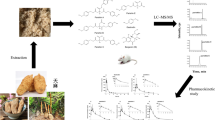Abstract
The biotransformation of isoflavones by gut microbiota and by drug metabolizing enzymes plays a crucial role in the understanding of their potential health-promoting effects. The purpose of our work was to develop a simultaneous, sensitive, and robust automated ultra high performance liquid chromatography tandem mass spectrometry (UHPLC-MS/MS) method to quantify the soy isoflavones daidzein and genistein, their conjugative metabolites, as well as their major microbial degradation products in order to provide a method for use in large clinical trials or animal studies. An automated, 96-well solid-phase extraction method was used to extract the isoflavone analytes from plasma and urine. Separation of genistein, daidzein, and 19 of its metabolites, including five glucuronides, seven sulfates, and two sulfoglucuronides, as well as five microbial metabolites, was achieved in less than 25 min using a sub-2 μm particle column and a gradient elution with acetonitrile/methanol/water as mobile phases. Analysis was performed under negative ionization electrospray MS via the multiple reaction monitoring (MRM). Validation was performed according to the analytical method validation guidelines of Food and Drug Administration (FDA) and International Conference on Harmonization of Technical Requirements for Registration of Pharmaceuticals for Human Use (ICH) consisting of selectivity, accuracy, precision, linearity, limit of detection, recovery, matrix effect, and robustness. All validated parameters essentially matched the FDA and ICH requirements. The application of this method to a pharmacokinetic study in postmenopausal women showed that isoflavones are extensively metabolized in vivo. A robust automated analytical approach was developed, which allows the handling of large sample sizes but nevertheless provides detailed information on the isoflavone metabolite profile leading to a better understanding and interpretation of clinical and animal studies.



Similar content being viewed by others
References
Mortensen A, Kulling SE, Schwartz H, Rowland I, Ruefer CE, Rimbach G, Cassidy A, Magee P, Millar J, Hall WL, Birkved FK, Sorensen IK, Sontag G (2009) Mol Nutr Food Res 53:S266–S309
Klein MA, Nahin RL, Messina MJ, Rader JI, Thompson LU, Badger TM, Dwyer JT, Kim YS, Pontzer CH, Starke-Reed PE, Weaver CM (2010) J Nutr 140:1192S–1204S
Takeuchi S, Takahashi T, Sawada Y, Iida M, Matsuda T, Kojima H (2009) Biol Pharm Bull 32:195–202
Zhang Y, Song TT, Cunnick JE, Murphy PA, Hendrich S (1999) J Nutr 129:399–405
Pugazhendhi D, Watson KA, Mills S, Botting N, Pope GS, Darbre PD (2008) J Endocrinol 197:503–515
Kinjo J, Tsuchihashi R, Morito K, Hirose T, Aomori T, Nagao T, Okabe H, Nohara T, Masamune Y (2004) Biol Pharm Bull 27:185–188
Ishii J, Hosoda K, Furuta T (2013) In: Preedy VR (ed) Isoflavones: chemistry analysis function and effects. Royal Society of Chemistry, London
Grace PB, Mistry NS, Carter MH, Leathem AJC, Teale P (2007) J Chromatogr B 853:138–146
Kuklenyik Z, Ye X, Reich JA, Needham LL, Calafat AM (2004) J Chromatogr Sci 42:495–500
Twaddle NC, Churchwell MI, Doerge DR (2002) J Chromatogr B 777:139–145
US Department of Health and Human Services, Food and Drug Administration (2001) Guidance for industry: bioanalytical method validation
The International Conference on Harmonization of Technical Requirements for Registration of Pharmaceuticals for Human Use (1994) Validation of analytical procedures: text and methodology
Al-Maharik N, Botting NP (2010) J Label Compd Radiopharm 53:95–103
Fairley B, Botting NP, Cassidy A (2003) Tetrahedron 59:5407–5410
Al-Maharik N, Botting NP (2008) Eur J Org Chem 2008:5622–5629
Matuszewski BK, Constanzer ML, Chavez-Eng CM (2003) Anal Chem 75:3019–3030
Rauha J-P, Vuorela H, Kostiainen R (2001) J Mass Spectrom 36:1269–1280
Mallet CR, Lu Z, Mazzeo JR (2004) Rapid Commun Mass Spectrom 18:49–58
Hopfgartner G, Varesio E, Tschäppät V, Grivet C, Bourgogne E, Leuthold LA (2004) J Mass Spectrom 39:845–855
The Commission of the European Communities (2002) Council Directive 96/23/EC concerning the performance of analytical methods and the interpretation of results
Guy L, Védrine N, Urpi-Sarda M, Gil-Izquierdo A, Al-Maharik N, Boiteux J-P, Scalbert A, Rémésy C, Botting NP, Manach C (2008) Nutr Cancer 60:461–468
Maubach J, Bracke ME, Heyerick A, Depypere HT, Serreyn RF, Mareel MM, De Keukeleire D (2003) J Chromatogr B 784:137–144
Csanády GC, Oberste-Frielinghaus H, Semder BS, Baur CB, Schneider KS, Filser JF (2002) Arch Toxicol 76:299–305
Hosoda K, Furuta T, Ishii K (2011) Drug Metab Dispos 39:1762–1767
Chen L, Zhao X, Fang L, Games DE (2007) J Chromatogr A 1154:103–110
Bayer T, Colnot T, Dekant W (2001) Toxicol Sci 62:205–211
Dams R, Huestis MA, Lambert WE, Murphy CM (2003) J Am Soc Mass Spectrom 14:1290–1294
Acknowledgments
This work was funded by the German Research Foundation (DFG), grant KU-1079/10-1. The project is part of the collaborative research project entitled IsoCross “Isoflavones: Cross-species comparison on metabolism, estrogen sensitivity, epigenetics, and carcinogenisis”. The authors thank Professor Achim Bub, Department of Physiology and Biochemistry of Nutrition, Max Rubner-Institut, for providing the plasma and urine samples.
Author information
Authors and Affiliations
Corresponding author
Additional information
Nigel Botting passed away on 4 June 2011
Electronic supplementary material
Below is the link to the electronic supplementary material.
ESM 1
(PDF 316 kb)
Rights and permissions
About this article
Cite this article
Soukup, S.T., Al-Maharik, N., Botting, N. et al. Quantification of soy isoflavones and their conjugative metabolites in plasma and urine: an automated and validated UHPLC-MS/MS method for use in large-scale studies. Anal Bioanal Chem 406, 6007–6020 (2014). https://doi.org/10.1007/s00216-014-8034-y
Received:
Revised:
Accepted:
Published:
Issue Date:
DOI: https://doi.org/10.1007/s00216-014-8034-y




